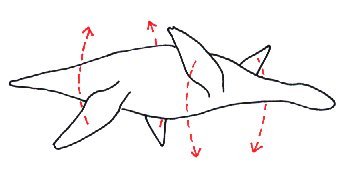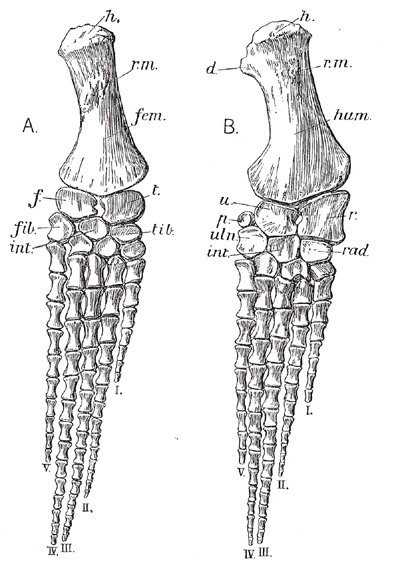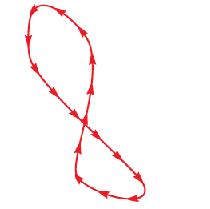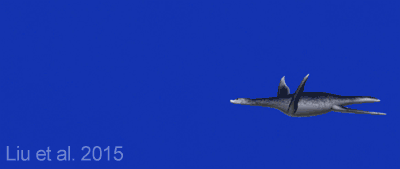Locomotion

How did plesiosaurs swim?
There is no other animal with four large flippers like a plesiosaur. This has led to much debate about plesiosaur locomotion (Robinson 1975). The tail in plesiosaurs is short, so while it may have provided some assistance as a rudder, it was not used for propulsion. Plesiosaurs were paraxial swimmers – they used their limbs to swim. In this regard they are like turtles and penguins, but different to fish, whales, mosasaurs, and ichthyosaurs, which are paraxial swimmers – they undulate their body and tail for propulsion. The short torso of plesiosaurs is reinforced with well-formed gastralia (belly ribs) and a tightly articulated spine, which minimised flexibility and provided a sturdy base for limb movement. But how did the limbs move – what was their stroke? Firstly, we have to consider the different possible ways an individual plesiosaur limb may have moved.

The rowing hypothesis
In rowing, a strong backstroke provides the thrust, and the recovery stroke is ‘feathered’ (rotated so the flipper cuts through the water like a blade). The plane of movement is horizontal (forwards-backwards). Early researchers supposed that plesiosaurs were rowers, but it is unlikely. The plesiosaur limb would make and inefficient paddle and the joints are adapted for vertical movement rather than horizontal movement. The skeleton animations of proposed limb paths on this page are by Louisa King, used here with kind permission.

Video showing a rowing limb motion
Robinson (1975) used several lines of evidence to discount the rowing hypothesis. Rowing animals have oar-like limbs to increase drag, but plesiosaur’s tapering hydrofoil-shaped limbs would help reduce drag. The joint that connects each propodial (humerus/femur) to the girdle (pelvic and pectoral) allows a greater amount of dorso-ventral (up and down) motion than anterior-posterior (forward-backwards) motion, which would inhibit a rowing motion but facilitate a up-down stroke.
The sub-aqueous flying hypothesis
Both strokes are powerful and provide thrust: this method provides constant thrust. The plane of movement is vertical (up and down). Verdict – limbs designed for flying, with tapered tips, but overall unlikely – the limbs could not be raised far above the horizontal.

Video showing a flying limb motion
The ‘modified flying‘ hypothesis
Modified flying combines principles of both rowing and flying. The downstroke provides thrust and lift as in flying and the more-or-less passive recovery stroke is feathered, as in rowing. Verdict – Most likely.

Video showing a modified flying limb motion
So, the general consensus is that plesiosaurs ‘flew’ underwater. Their limbs should therefore be described as flippers rather than paddles.
The four-limb problem
But how did the four limbs move relative to each other? Again, there are at least three option.
The alternating hypothesis
An alternating gait in which the fore and hind limb move out of sequence was portrayed in the BBC’s Walking with Dinosaurs television series (episode 3, Cruel Sea).

employed by plesiosaurs.
Video showing the alternating gait hypothesis
Justification for this hypothesis was provided by Frey and Riess (1982). The pectoral and pelvic girdles are expanded ventrally (below) but not dorsally. This provides plenty of surfaces for the attachment of muscles involved in a very powerful downstroke, but suggest a weaker upstroke (Massare, 1988). To compensate for the lack of thrust during the weak upstroke of one limb pair, the other pair could provide thrust with a powerful downstroke. This would hypothetically enable constant forward motion of the animal and efficient locomotion.
The one-pair-only hypothesis
Other researchers (Lingham-Soliar 2000) have regarded the rear limbs as being of little use in propulsion. The hind flippers in Meyerasaurus are slightly less recurved in the rear flippers, which could suggest a different function to the fore flippers.
Video showing the ‘one-pair-only’ gait hypothesis
The synchronous hypothesis
Other researchers (Sanders et al. 2004) have endorsed a gait in which all four-flippers move in synchrony. Read more about this on Mike Everhart’s website ‘Oceans of Kansas’).
Video showing the synchronous gait hypothesis
Plesiosaurs may have performed short bursts of speed by combining the down stroke of both limb pairs simultaneously, to take prey by surprise, or to avoid a predator.
Computer simulations of plesiosaur swimming
I was fortunate to be involved in a research project to investigate plesiosaur swimming using computer simulations (Liu et al. 2015). The paper is open access and I summarised the project and its findings on the blog. Essentially, the results suggest that plesiosaurs were forelimb-dominated swimmers with a modified flying limb stroke. The gait is a combination of ‘one-pair-only’ and ‘synchronous’. The hind-limbs in the simulations didn’t provide very efficient propulsion so we concluded they were used mostly for changing direction. The computer simulations were only searching for the most ‘stable’ steady cruising gaits, so the hind limbs may also have been used for short bursts of ‘unstable’ propulsion.


Movement on land
Whether plesiosaurs could move about on land has been a point of contention. The mechanics of the skeleton suggest a completely aquatic lifestyle. There is only one articulation in each limb – the shoulder joint in the forelimb and the hip joint in the hind limb – so the flippers couldn’t be folded or repurposed as legs. The limb girdles are only weakly connected to the backbone, which would inhibit transfer of force from limb-strokes on land into movement of the body. Also, unlike turtles, plesiosaurs gave birth to live young, so they did not need to come onto land to lay eggs. Maybe small plesiosaurs were relatively unaffected by the physical constraints of the skeleton. It is not unreasonable to imagine them using their powerful limb downstrokes to propel themselves forward in ungainly short ‘hops’. However, large plesiosaurs with a great body mass were highly unlikely to be able to survive for long out of water.

